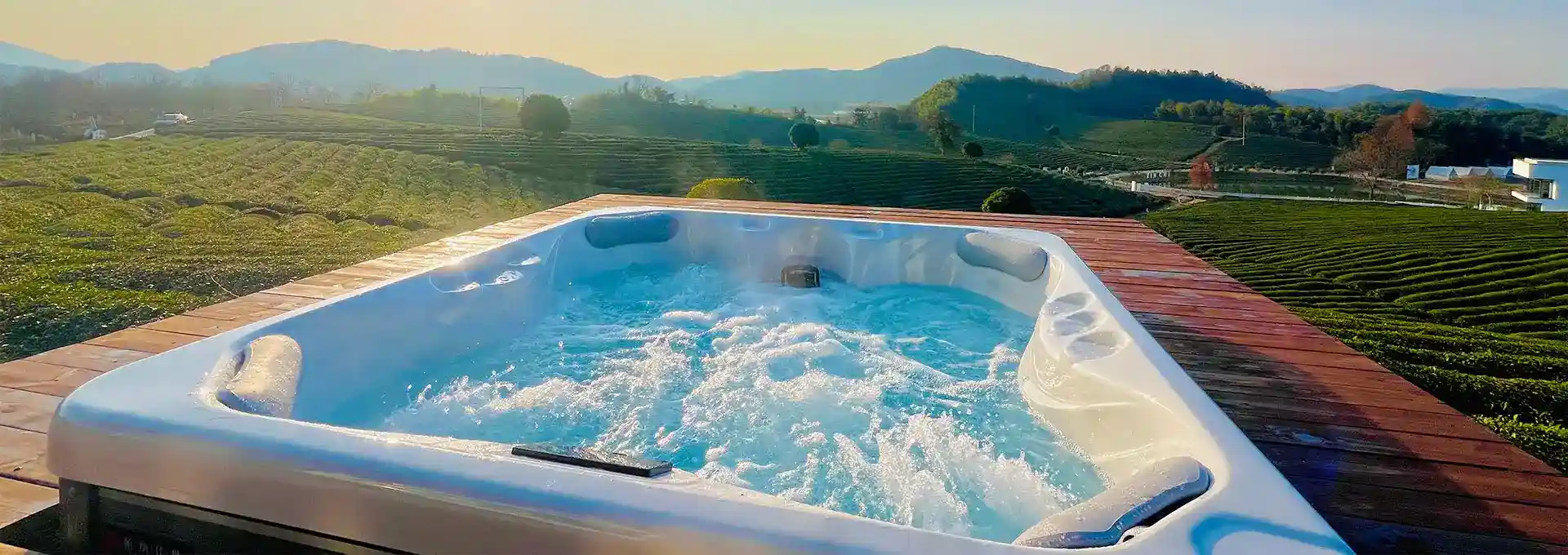What is Required to Install a Hot Tub?
2024-08-28 17:27:17
Installing a hot tub can transform your outdoor space into a relaxing oasis, but it requires careful planning and preparation. From choosing the right location to ensuring proper electrical and plumbing connections, there are several important factors to consider before embarking on this exciting home improvement project. In this comprehensive guide, we'll explore the key requirements for installing a hot tub, helping you understand the process and make informed decisions.
How much does it cost to install an outdoor hot tub?
The cost of installing an outdoor hot tub can vary significantly depending on several factors. On average, you can expect to spend between $3,000 and $20,000 for the entire project. This wide range is due to the many variables involved in the installation process.
First, the cost of the hot tub itself is a major factor. Entry-level models may start around $2,000, while high-end luxury spas can cost upwards of $15,000. The size, features, and brand of the hot tub will all influence its price.
Next, you'll need to consider the cost of site preparation. This includes creating a stable, level foundation for your hot tub. Options range from a simple gravel bed to a custom-built deck or concrete pad. Depending on the complexity of the project, site preparation can cost anywhere from $500 to $5,000 or more.
Electrical work is another significant expense. Most hot tubs require a dedicated 220-volt circuit, which often necessitates upgrading your home's electrical panel. Professional electrical installation can range from $1,000 to $3,000, depending on the complexity of the work and local labor rates.
If you're installing your hot tub some distance from your house, you may need to factor in the cost of trenching for electrical conduit and potentially water lines. This can add several hundred to a few thousand dollars to your project cost.
Additional expenses may include:
- Delivery and placement of the hot tub ($200-$500)
- Plumbing work, if needed ($500-$1,500)
- Permits and inspections ($100-$500)
- Landscaping around the hot tub ($500-$5,000)
- Accessories like steps, covers, and lighting ($500-$2,000)
It's important to budget for ongoing costs as well. These include increased electricity bills (typically $20-$50 per month), water and chemical costs for maintenance, and potential repairs or service calls.
While the initial investment may seem substantial, many homeowners find that the long-term benefits of having a private, relaxing retreat in their backyard outweigh the costs. To manage expenses, consider getting multiple quotes from reputable installers, and don't be afraid to negotiate on price or ask about package deals that include accessories or maintenance services.
What type of foundation is needed for an outdoor hot tub?
Choosing the right foundation for your outdoor hot tub is crucial for its longevity, safety, and performance. The foundation must be able to support the considerable weight of the filled hot tub, which can exceed several thousand pounds when accounting for water, equipment, and occupants.
The most common types of foundations for outdoor hot tubs include:
1. Concrete Pad: This is often considered the gold standard for hot tub foundations. A properly constructed concrete pad provides a stable, level surface that can easily support the weight of a full hot tub. The pad should be at least 4 inches thick and reinforced with rebar or wire mesh for added strength. The surface area should extend at least 6 inches beyond the hot tub's dimensions on all sides. While a concrete pad is durable and low-maintenance, it requires professional installation and can be costly.
2. Prefabricated Spa Pad: These are specially designed plastic or composite pads that can support the weight of a hot tub. They're lightweight, easy to install, and often more affordable than concrete. However, they may not be suitable for all soil types or larger hot tubs.
3. Gravel Bed: A compacted gravel base can be a cost-effective option for some installations. It requires excavating the area, laying landscape fabric to prevent weed growth, and adding several inches of compacted gravel. While this can work well in some situations, it may not provide as stable a surface as concrete and can be prone to settling over time.
4. Deck: If you're installing your hot tub on an existing deck or planning to build a new one, ensure that the structure is designed to support the weight of the filled hot tub. This often requires additional reinforcement and may need to be approved by a structural engineer.
5. Pavers or Brick: Interlocking pavers or bricks set on a compacted base can provide an attractive and functional foundation. However, ensure that the base is properly prepared and leveled to prevent settling or shifting.
Regardless of the type of foundation you choose, there are several key considerations to keep in mind:
- Drainage: The foundation should have a slight slope (about 1/4 inch per foot) to allow water to drain away from the hot tub and your home's foundation.
- Accessibility: Ensure that the foundation allows easy access to the hot tub's equipment panel for maintenance and repairs.
- Local Codes: Check with your local building department to ensure your chosen foundation meets all relevant codes and regulations.
- Load-Bearing Capacity: Confirm that your chosen foundation can support the total weight of your filled hot tub, including water, equipment, and maximum occupancy.
- Levelness: The foundation must be perfectly level to ensure proper water distribution and prevent stress on the hot tub's structure.
- Surrounding Area: Consider the aesthetics and functionality of the area around the hot tub, including space for steps, towel racks, or seating.
By carefully considering these factors and choosing the right foundation for your specific situation, you'll ensure that your outdoor hot tub is safe, stable, and ready to provide years of relaxation and enjoyment.
How do you maintain water quality in an outdoor hot tub?
Maintaining proper water quality in your outdoor hot tub is essential for both the health of users and the longevity of the tub itself. Clean, balanced water not only feels and smells better but also helps prevent skin irritation, equipment damage, and the growth of harmful bacteria. Here's a comprehensive guide to keeping your hot tub water in top condition:
1. Regular Testing: The foundation of good water quality is frequent testing. Use test strips or a digital tester to check the water's pH, alkalinity, and sanitizer levels at least 2-3 times per week. The ideal ranges are:
- pH: 7.2 to 7.8
- Alkalinity: 80 to 120 ppm (parts per million)
- Chlorine: 1 to 3 ppm
- Bromine: 3 to 5 ppm
2. Balancing Chemicals: Based on your test results, add the necessary chemicals to bring your water into the proper range. This may include pH increasers or decreasers, alkalinity boosters, or calcium hardness adjusters. Always follow the manufacturer's instructions for dosing.
3. Sanitizing: Choose between chlorine or bromine as your primary sanitizer. Each has its pros and cons:
- Chlorine works quickly but can have a strong odor and may irritate sensitive skin.
- Bromine is gentler and more stable at high temperatures but takes longer to dissipate when overapplied.
Add sanitizer regularly, especially after heavy use or rainfall. Some hot tub owners use mineral purifiers or ozonators to reduce the amount of chemical sanitizer needed.
4. Shocking the Water: Perform a weekly "shock" treatment to oxidize contaminants and reactivate your sanitizer. This involves adding a large dose of oxidizer (either chlorine or non-chlorine shock) to break down organic matter and kill bacteria.
5. Cleaning Filters: Clean your hot tub filters every 2-4 weeks, depending on usage. Rinse them with a garden hose or use a filter cleaning solution. Deep clean or replace filters every 3-4 months.
6. Maintaining Water Level: Keep the water level at the recommended height, typically about 1 inch above the highest jet. Low water can damage the pump and heater.
7. Draining and Refilling: Completely drain and refill your hot tub every 3-4 months, or more frequently with heavy use. This prevents the buildup of total dissolved solids (TDS) that can make water balancing difficult.
8. Cleaning the Shell: When you drain the tub, take the opportunity to clean the shell with a non-abrasive cleaner designed for hot tubs. Pay special attention to the waterline and any crevices where buildup can occur.
9. Cover Care: Keep your hot tub cover clean and in good repair. A well-maintained cover helps prevent debris from entering the water and reduces chemical loss through evaporation.
10. Showering Before Use: Encourage all users to shower before entering the hot tub. This simple step can significantly reduce the amount of contaminants introduced to the water, making maintenance easier.
11. Addressing Specific Issues:
- Cloudy Water: This often indicates a filtration or sanitizer issue. Check and clean filters, shock the water, and ensure proper sanitizer levels.
- Foamy Water: Caused by soap residues or high TDS levels. Use an anti-foam product and consider draining and refilling if persistent.
- Green Water: Typically a sign of algae growth. Shock the water, clean filters, and maintain proper sanitizer levels.
12. Natural Alternatives: Some hot tub owners prefer to minimize chemical use. While it's challenging to maintain a completely chemical-free hot tub, you can reduce chemical dependency by:
- Using an ozonator or UV system to supplement sanitizer
- Employing enzyme-based products to break down organic contaminants
- Increasing filtration time to improve water clarity
13. Professional Services: Consider having your hot tub professionally serviced once or twice a year. A technician can perform a thorough cleaning, check equipment, and address any potential issues before they become problems.
By following these maintenance practices, you'll ensure that your outdoor hot tub remains a clean, safe, and inviting retreat. Remember, consistency is key – regular, small efforts in maintenance can prevent larger issues down the line, saving you time and money while maximizing your enjoyment of your outdoor oasis.
If you want to get more information about this product, you can contact us at info@iparnassus.com!
References:
1. Hot Spring Spas. "Hot Tub Installation Guide."
2. Swim University. "How to Install a Hot Tub Properly."
3. Home Advisor. "How Much Does a Hot Tub Cost to Install?"
4. Bullfrog Spas. "Hot Tub Foundation Options."
5. Pool Research. "Hot Tub Installation Cost."
6. Master Spas. "Hot Tub Water Care Guide."
7. The Spruce. "How to Maintain Your Hot Tub."
8. Aqua Magazine. "The Basics of Hot Tub Water Care."
9. Hot Tub Owner HQ. "Hot Tub Installation: A Complete Guide."
10. Leslie's Pool Supplies. "Hot Tub Maintenance 101."



